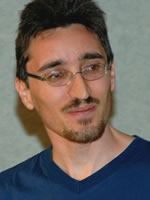Fausto Giunchiglia
fausto [ at ] disi.unitn.it |
Alessandro Agostini
agostini [ at ] disi.unitn.it |
Vincenzo Maltese
maltese [ at ] disi.unitn.it |
Rui Zhang
zhang [ at ] disi.unitn.it |
| Home |
Fausto Giunchiglia
fausto [ at ] disi.unitn.it |
Alessandro Agostini
agostini [ at ] disi.unitn.it |
Vincenzo Maltese
maltese [ at ] disi.unitn.it |
Rui Zhang
zhang [ at ] disi.unitn.it |
COURSE OBJECTIVES AND OUTCOMES
The goal of this course is to provide motivations, definitions and
techinques in support of the usefulness of logic in the effective and
efficient modeling of data and knowledge.
The course will have succeeded if it stimulates the interested
students to continue their career with higher interest into
logic-based models for data and knowledge representation in their own
field of expertise, and to produce computer-processable solutions of
relevant problems.
GENERAL DESCRIPTION
The use of logic in computer science is very well-documented. The
exponential increase of literature on every area of computer science
has forced both definition and use of logical formalisms for knowledge
representation and reasoning into greater complexity, and this
complexity has in turn necessitated a deeper study of the principles
by which logical models may be constucted. It has become more and more
apparent, say since the 1989' First International Conference on the
Principles of Knowledge Representation and Reasoning (KR-89), that
knowledge representation models and reasoning models are only
different views of the same common problem.
Different logic-based approaches to data and knowledge representation
and reasoning are beginning to converge. It seems therefore useful to
try to accelerate this process by trying to provide a survey, as
uniform as possible presentation of the whole problem of logic-based
modeling of data and knowlege, treating the subject on general
theoretical lines, yet filled in with practical examples from
real-world scenarios, problems and applications, with a particular
attention paid to the borderlines and inter-relationships among all
logics presented.
There is as yet no unified theory of logic-based models for data and
knowledge representation, and a good deal of practical systems and
working devices are not logic-based in their design foundation and
unsullied by any logical model. There is nevertheless a real need for
the subject to be looked at as a whole.
PREREQUISITES
Mathematical logic knowledge at the undergraduate graduate level is
strongly recommended. The prerequisite topics are covered, for
example, by the course "Mathematical logic" of the first year of the
Master Program in Computer Science.
The course provides the necessary definitions, properties and
examples, as well as pointers to the suggested background
readings.
The ability to follow and appreciate abstract arguments is
encouraged.
COURSE'S CONTENTS
LECTURES - TEACHING METHODOLOGY
Formal lectures with lots of examples and exercises will be held twice
a week on Tuesdays and Thursdays for 1.5 hours according to the
scheduling above.
You are responsible for material presented in lectures, including oral
comments made by the lecturers.
The course encourages and increases the opportunities for students to
be involved in research under the guidance of the lecturers. As soon
as our LDKR Web 2.0 platform has been activated (see below), the
course actively engages students in learning opportunities provided by
adding extra-contents like examples, questions and exercises on the
course's topics.
HANDOUTS
All material presented in class will be available through handouts.
Most handouts (i.e., lectures notes or 6 pages per sheet slides'
layout) will be made available on the server in formats suitable for
printing. Students should download and print out the handouts from
this site---please see the links in the course. We will post the
material a few days after each lecture, if not stated otherwise.
BASIC READINGS
SUGGESTED READINGS
A list of suggested readings (e.g. chapters in advanced/reference
textbooks and collections, and research papers) will be available
as the course proceeds.
http://www.cambridge.org/catalogue/catalogue.asp?
isbn=0521781760.
See expecially 1,2,4,10, all available online. For example here:
Ch 1: "An Introduction to Description Logics"
Ch 2: "Basic Description Logics"
Ch 4: "Relationships with other formalisms"
Ch 10: "Conceptual Modelling with Description Logics".
http://www.ics.forth.gr/isl/swprimer/.
OTHER RESOURCES
A list of web resources will be available as the course proceeds.
EXAMINATION AND GRADING
The exam consists of various written exercises and tests. An exercise
can be: a "yes/no" question, proving some simple properties,
formalizing an informal specification, and so on. There is also an
optional oral examination, which starts from a discussion of the
written exam.